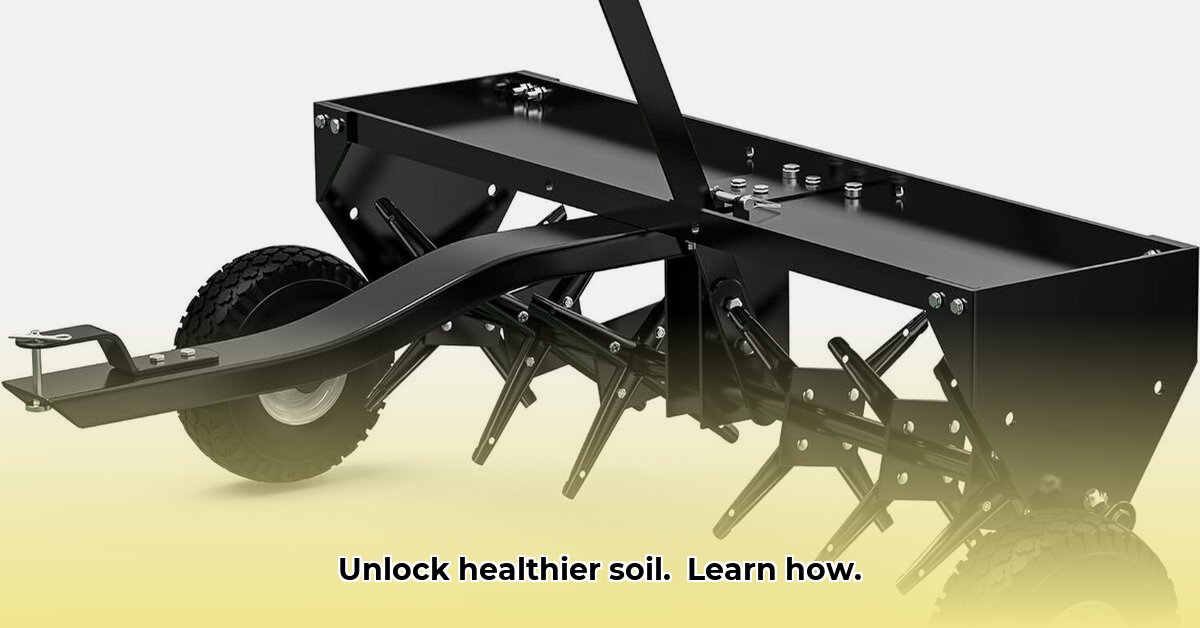
Want healthier, more productive crops? It all starts with healthy soil! This guide shows you how to improve your soil health using aerators from Tractor Supply. We'll cover choosing the right tool, using it effectively, and maintaining it for long-term use. Whether you're a seasoned farmer or just starting, this practical guide will help you unlock the full potential of your land. For more information on 3-point aerators, check out this helpful resource.
Understanding Your Soil: The Foundation of Success
Before you buy an aerator, understand your soil type. Is it clay (heavy and compact), sandy (loose and drains quickly), or loamy (a balanced mix)? Different soils need different aeration approaches. Think of trying to aerate a brick versus a loose pile of sand – it's a world of difference!
A simple soil test kit (easily found online or at your local garden center) quickly identifies your soil type. This is crucial; choosing the wrong aerator for your soil is like using the wrong tool for the job – a waste of time and effort. For a more comprehensive assessment, consider taking multiple soil samples from different areas of your field. Even seemingly uniform fields can have variations in soil composition.
Selecting the Right Aerator at Tractor Supply
Tractor Supply offers several aerators, each designed for different soil conditions and farm sizes. The two main types are plug aerators and core aerators. Which one is right for your farm?
Plug Aerators: These create small holes in the soil, improving drainage and air circulation. They’re ideal for smaller areas and less compacted soils like sandy or loamy soils. They're generally less expensive and easier to use. However, they might not be as effective on heavily compacted clay soils.
Core Aerators: These remove small cores of soil, creating larger openings. This aggressive approach is best for heavily compacted clay soils and larger farms, significantly improving drainage. However, they’re more expensive and require more effort to operate.
| Aerator Type | Pros | Cons | Ideal For |
|---|---|---|---|
| Plug Aerator | Less expensive, easier to use, good for smaller areas | Less effective on heavy clay, less overall aeration | Small gardens, lawns, sandy or loamy soils, less compacted soils |
| Core Aerator | Removes soil plugs, more effective on heavy clay | More expensive, more labor-intensive, requires more space | Larger areas, heavy clay, significant drainage improvement |
While specific models vary, Tractor Supply’s staff can help you choose the best aerator for your needs and budget. Their expertise on local soil conditions is invaluable.
Aeration Techniques: A Step-by-Step Guide
Now, let's get to the practical part! Here's how to effectively aerate your soil:
Step 1: Preparation: Clear the area of any rocks, debris, or large clumps of vegetation. This prevents damage to your aerator and ensures even aeration.
Step 2: Choose Your Aerator: Select the appropriate aerator based on your soil type and the size of the area. Refer to the table above for guidance.
Step 3: The Aeration Process: Follow the manufacturer’s instructions carefully. For core aerators, slightly overlapping passes ensure consistent coverage. With plug aerators, maintain even spacing between holes. Consider the depth of aeration; research suggests deeper aeration benefits certain plants more than others. This is an active area of ongoing agricultural research.
Step 4: Post-Aeration Care: Lightly water the aerated area to help settle the soil and encourage root growth. Adding compost or other organic matter further improves soil health.
Safety First: Always wear appropriate footwear and eye protection while operating an aerator.
Integrating Aeration into Sustainable Practices
Soil aeration isn't a standalone solution; it's part of a broader sustainable farming strategy. It works exceptionally well with other soil-improving practices like cover cropping (planting crops to improve soil health) and composting. By improving drainage and nutrient availability, you reduce your reliance on chemical fertilizers and pesticides, benefiting both your farm and the environment. This holistic approach fosters long-term soil health.
Maintaining Your Aerator: Extending its Lifespan
Regular maintenance is key to maximizing your aerator's lifespan. After each use, clean it thoroughly to remove soil buildup. Lubricate moving parts regularly to prevent wear and tear. Addressing minor issues (like a loose bolt) promptly prevents more significant problems later. Proper storage protects it from damage and rust. A well-maintained aerator will serve you for years to come.
Conclusion: Breathe New Life into Your Soil
Healthy soil is the cornerstone of successful farming. By taking the time to understand your soil and choosing the right aerator from Tractor Supply, you’re investing in a healthier, more productive future for your land. Remember, soil health is an ongoing process; continuous monitoring and adjustment may be needed for optimal results. Start aerating today and reap the rewards of a thriving farm!